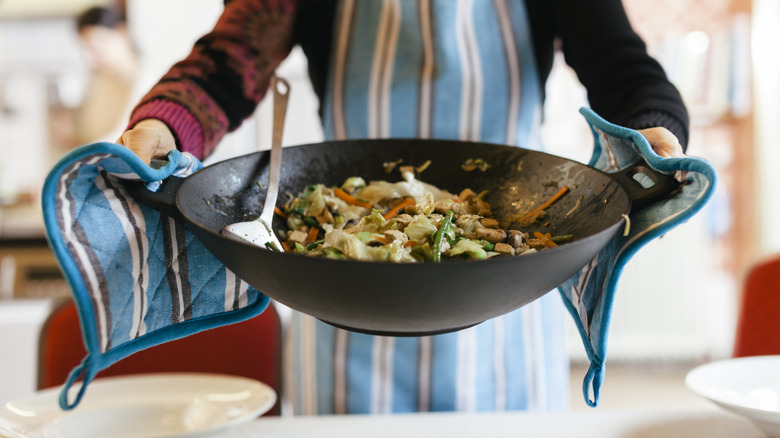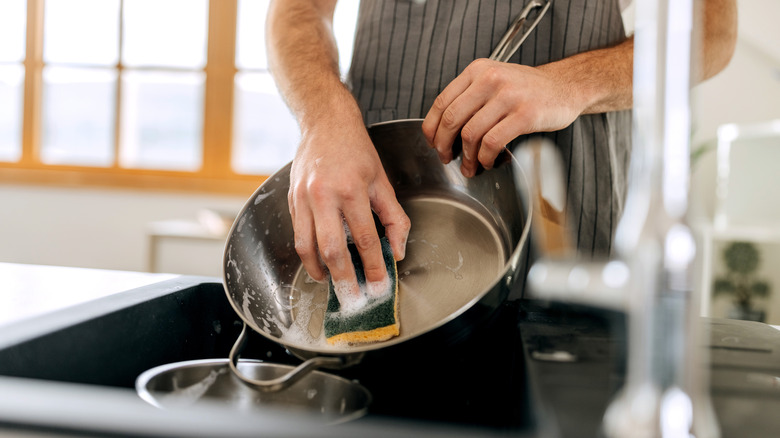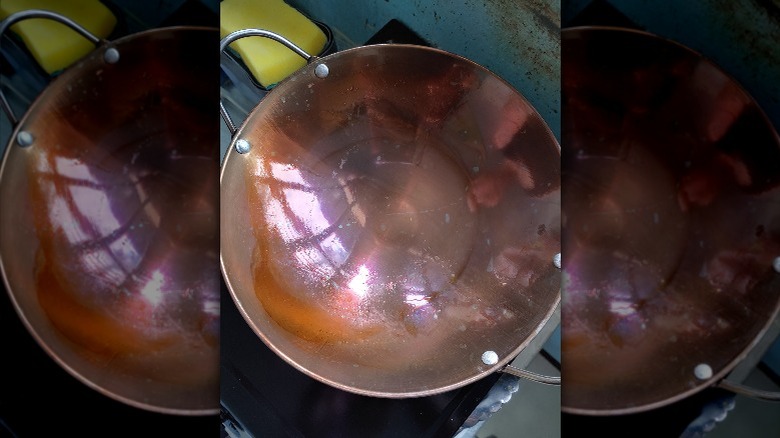Here's How To Season Your Brand New Wok
If you're like me, then the first time you heard about seasoning a wok, you thought it was an opportunity to make a trip to the cupboard and grab some of your favorite aromatic bagged spices and get to work. Seemed strange, but I thought it was some fancy technique that would somehow impart flavor to the food. Turns out, seasoning your brand new wok has nothing to do with dried herbs and spices... even if that's how it sounds!
Seasoning is non-negotiable; failure to do so will leave you with a mess of ingredients vehemently refusing to let go of the surface of the wok. Nothing is more frustrating than a sticky wok that leaves you searching the internet for ways to get burnt food off the bottom of the pan. It just makes cooking and even cleanup, for that matter, more difficult.
So yeah, seasoning your wok is a must because it protects it from rust and creates a natural, non-stick layer that makes cooking a breeze. The process may sound involved, but it's surprisingly simple and makes a massive difference in how your food turns out. I bought mine in the hope of creating the perfect fried rice and the process was so much easier after creating the non-stick surface. If you're excited about your brand new wok and want to hit the ground running when you go to cook all of your favorite recipes, let me walk you through the steps on how to season it the correct way.
Preparing the wok for seasoning
We'll kick things off by thoroughly washing the new wok to remove any factory oils or residues. My go-to is warm water and a bit of dish soap, scrubbing it with a sponge until it's spotless. Don't forget to rinse and dry it completely. This is not a throwaway step, as any leftover moisture or residue can interfere with the seasoning process. How do I know this? Because I half-did this step the first time I got a wok and it didn't end well.
Next, put the wok on the stove over medium heat to dry it and to start warming up the metal. As it heats up, you might notice a slight color change. Don't be alarmed: This is normal and just part of the process. I like to let it get blazing hot before moving on to the next step. Warming it up helps the oil adhere better, creating that smooth, seasoned layer we're aiming for.
Applying the oil and building the seasoned layer
Now that my wok is hot and dry, it's time to apply the oil. Make sure to use an oil with a high smoke point, like vegetable or grapeseed oil, as they're ideal for seasoning. Pour a small amount (just enough to coat the inside of the wok) and then use a paper towel to rub it evenly across the surface. Be careful here because the wok will be very hot!
After coating the wok with oil, let it continue to heat on the stove over medium-high heat. You'll see the oil start to smoke slightly, which is a sign it's bonding to the metal. Keep the wok over the heat for 10 to 15 minutes, letting it smoke and build up that seasoned layer. Then, remove it from the heat, let it cool, and repeat the oiling and heating process a couple more times to really build up a strong, non-stick layer.
By the end of this process, your wok should have a beautiful dark sheen, ready to cook up some great Asian-inspired dishes. If you've followed these simple steps, with a little care and regular use, your wok's seasoning will continue to improve, making it an indispensable tool in your kitchen.


